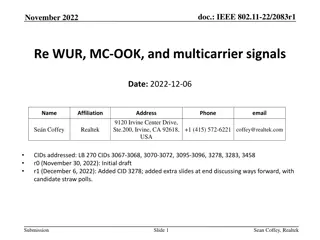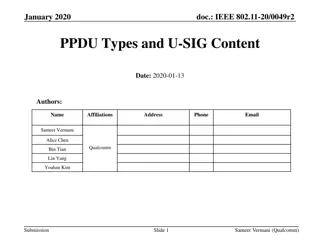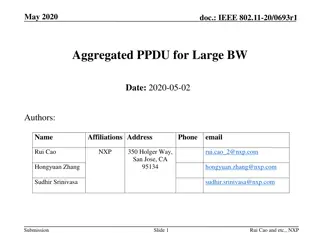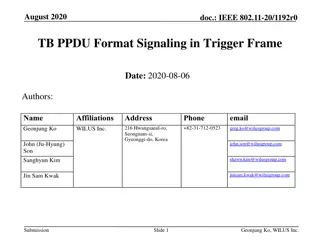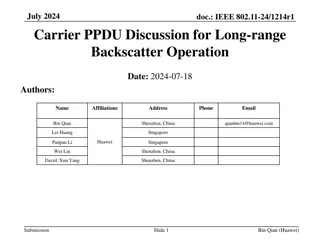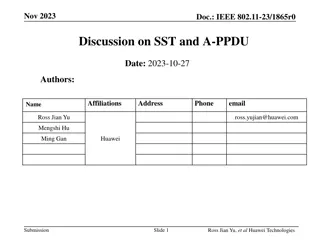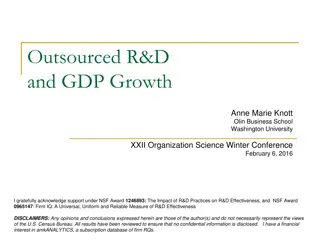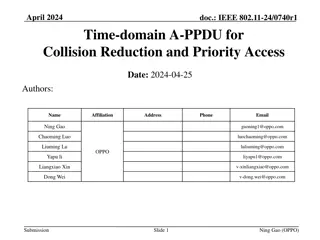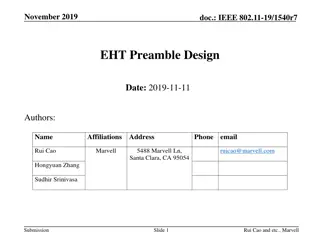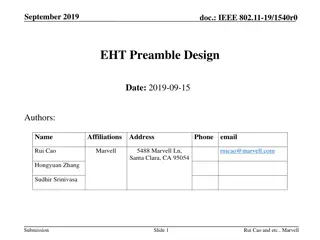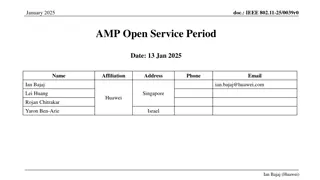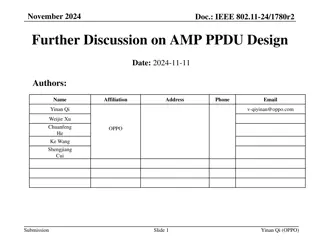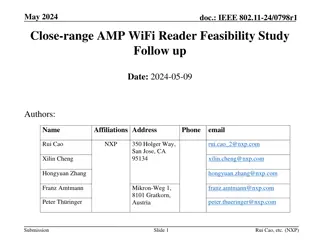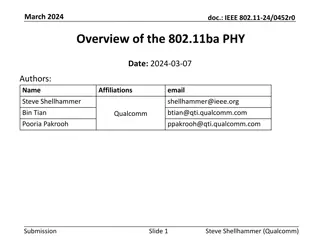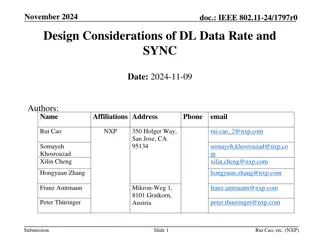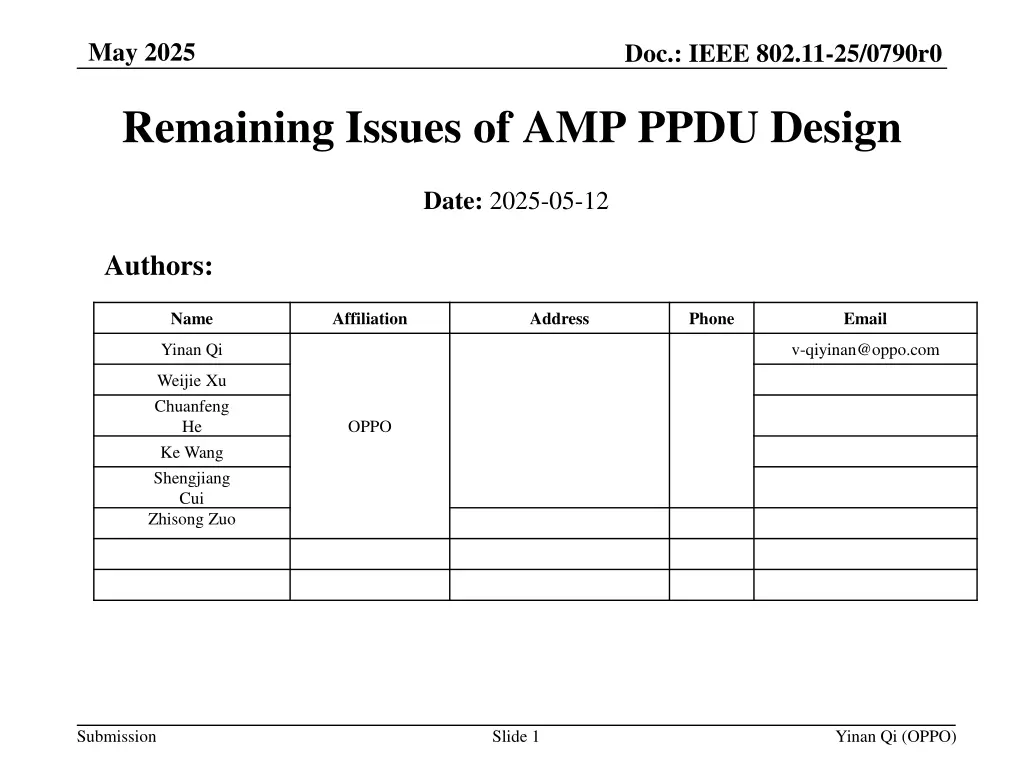
Remaining Issues in IEEE 802.11 AMP PPDU Design
This document discusses the open issues in IEEE 802.11 AMP PPDU design, including non-AMP preamble configuration, synchronization, SIG and data fields, waveform generation, PPDU format, and UL transmission configuration. It covers topics like non-AMP DL preamble format and configuration, U-SIG fields, and AMP synchronization design for UL and DL.
Download Presentation

Please find below an Image/Link to download the presentation.
The content on the website is provided AS IS for your information and personal use only. It may not be sold, licensed, or shared on other websites without obtaining consent from the author. If you encounter any issues during the download, it is possible that the publisher has removed the file from their server.
You are allowed to download the files provided on this website for personal or commercial use, subject to the condition that they are used lawfully. All files are the property of their respective owners.
The content on the website is provided AS IS for your information and personal use only. It may not be sold, licensed, or shared on other websites without obtaining consent from the author.
E N D
Presentation Transcript
May 2025 Doc.: IEEE 802.11-25/0790r0 Remaining Issues of AMP PPDU Design Date: 2025-05-12 Authors: Name Affiliation Address Phone Email Yinan Qi v-qiyinan@oppo.com Weijie Xu Chuanfeng He Ke Wang Shengjiang Cui Zhisong Zuo OPPO Submission Slide 1 Yinan Qi (OPPO)
Doc.: IEEE 802.11-25/0790r0 May 2025 Abstract In this contribution, we discuss the remaining open issues in AMP PPDU design covering issues such as non-AMP preamble configuration, synchronization, SIG and data fields, DL/UL waveform generation, PPDU format and UL transmission configuration. Submission Slide 2 Yinan Qi (OPPO)
May 2025 Doc.: IEEE 802.11-25/0790r0 Non-AMP DL Preamble Format Non-AMP legacy preamble includes L-STF, L-LTF, L-SIG, RL-SIG, and U-SIGs for Active Tx and AMP enabled devices For backscattering AMP device, additional preamble format, e.g., 802.11b like preamble can be used Single carrier DSSS Depending on the waveform of the following AMP portion Convergence is possible when AMP portion waveform is decided. Submission Slide 3 Yinan Qi (OPPO)
May 2025 Doc.: IEEE 802.11-25/0790r0 Non-AMP DL Preamble Configuration Configuration of L-SIG o Rate: configured as an unsupported rate Differentiate from WUR where rate is always configured as MCS0 Other legacy devices can stop reception once detecting unsupported rate o Length: configured as entire DL PPDU including excitation field(s) UL transmission parameters, e.g., payload size, rate, MCS, etc., are all configured by the AMP AP Configuration of RL-SIG o Instead of repetition of L-SIG, may consider other options, e.g., complement of L- SIG, to differentiate 802.11bp PPDU from legacy PPDU Submission Slide 4 Yinan Qi (OPPO)
May 2025 Doc.: IEEE 802.11-25/0790r0 Non-AMP DL Preamble Configuration Configuration of individual fields in U-SIG Two U-SIG formats available but need to choose only one for 802.11bp EHT MU PPDU can be chosen How to differentiate 802.11bp PPDU from 802.11be and 802.11bn PPDU? Validation fields, e.g., version For example, version field can be configured different from 802.11be and 802.11bn UL/DL: configured as DL if there is no excitation field and UL otherwise Txop can be configured as maximum value, so it actually does not indicate Txop duration. o o o o Submission Slide 5 Yinan Qi (OPPO)
May 2025 Doc.: IEEE 802.11-25/0790r0 AMP Synchronization Asymmetric synchronization design for UL and DL Different sync sequences in terms of pattern and/or length for DL/UL to differentiate UL and DL DL synchronization design In our companion contribution [1], it is shown that DL synchronization performance depends on sequence length, chip duration, sampling rate, etc. Sequence length: 16 and/or 32 Sampling rate: 2MHz or 8MHz Chip duration: same chip duration for 1Mbps and 250kbps for reduced complexity at AMP non-AP STA side: 0.5, 1 and 2 microsecond can be considered Main findings: cross-correlation with data portion may cause severe sync inaccuracy UL synchronization design A single synchronization sequence can be used for multiple data rates Chip rate can scale with data rate and short chip duration is used for higher rate with higher SNR to reduce signalling overhead AP does not need to do blind detection trying various chip duration with knowledge of UL transmission configuration. o o o o o o o o o Submission Slide 6 Yinan Qi (OPPO)
May 2025 Doc.: IEEE 802.11-25/0790r0 SIG Field and Payload Size DL SIG fields: length and/or payload size, backscatter indication, UL configuration to configure the following UL transmission in followed excitation field, CRC Alternatively, these information can also be conveyed in MAC header If in SIG, these basic information can always be transmitted with low rate for better link budget. Flexible payload size configuration for DL and UL Multiple frame formats need to be supported in DL including data, management and control frames For data frame, 802.11ba can still be a starting point Frame body is m*n m is the size of AMP non-AP STA ID, e.g., AID or compressed AID n is the number of AMP non-AP STAs to be addressed For UL, some fixed payload size can be defined to reduce signalling overhead and padding can be applied if needed. o o o Submission Slide 7 Yinan Qi (OPPO)
May 2025 Doc.: IEEE 802.11-25/0790r0 DL/UL waveform generation Agreement: The carrier waveform for AMP Downlink PPDU is constructed by repeating one predefined base waveform of TBD micro-second, we suggest having a bandwidth of 10M. DSSS Replace Barker code with another spreading code, which can generate a narrow bandwidth DSSS signal BW flexibly depends on the spreading code OFDM OFDM BPSK sequence to generate a narrow bandwidth OFDM signal as the predefined base waveform for around 10MHz. BW 10MHz leave sufficient guard band for various implementations [2]. Submission Slide 8 Yinan Qi (OPPO)
May 2025 Doc.: IEEE 802.11-25/0790r0 DL PPDU: Flexible BW and Waveform DL PPDU Different BW and waveforms can be considered for different fields including preamble, excitation, data, etc., to achieve optimized performance. Active Tx Preamble: 20MHz with OFDM waveform AMP part: no less than 10 MHz but can be DSSS waveform Backscattering Preamble: OFDM or DSSS AMP part All transmitted by the same node for mono-static case unified design Different fields can be transmitted by separated nodes for bi-static case different design for data portion and excitation o o o o o Submission Slide 9 Yinan Qi (OPPO)
May 2025 Doc.: IEEE 802.11-25/0790r0 PPDU Format New DL PPDU format Legacy nodes, e.g., existing legacy APs, mobile phones, as energizers could be without AMP protocol support AMP AP configures energizer and AMP non-AP STA with DL PPDU Energizer then transmits excitation to be used for AMP non-AP STA backscattering. Due to co-existence requirement, a legacy non-AMP preamble needs to be transmitted before the excitation field. Thus, a new PPDU format is needed. Decouple DL and UL for backscattering AMP non-AP STAs o o o Submission
May 2025 Doc.: IEEE 802.11-25/0790r0 UL Configuration Chip duration can scale with data rate and FEC coding o For example, 2us for 250kbps without FEC coding and 1us with FEC coding. UL BW, e.g., BW of the main lobe, can also scale with data rate. o Narrower BW for lower data rates. UL BW can also scale with data rate. o FDM may be applied at least for low data rate Submission Slide 11 Yinan Qi (OPPO)
May 2025 Doc.: IEEE 802.11-25/0790r0 UL Configuration: MCS FEC coding, e.g., convolutional coding with coding rate 1/2, can be supported for UL with 2.5dB coding gain [3] A baseline MCS table can be as follows. Rate has been decided with or without FEC coding Chip duration will change with FEC coding rate. MCS Index Device Type FEC Coding Rate Data Rate 0 Backscattering AMP device and Active AMP device 1/2 250 kbps 1 Backscattering AMP device and Active AMP device 1 250 kbps 2 Backscattering AMP device and Active AMP device 1 Mbps 3 Backscattering AMP device and Active AMP device 1 1 Mbps 4 Active AMP device 4 Mbps 5 Active AMP device 1 4 Mbps Submission Slide 12 Yinan Qi (OPPO)
May 2025 Doc.: IEEE 802.11-25/0790r0 Summary The following issues are discussed and analysed in this contribution o Preamble design o Synchronization design for both DL and UL o DL/UL SIG and payload size o DL/UL waveform generation o DL PPDU format o UL configuration, e.g., MCS Submission
May 2025 Doc.: IEEE 802.11-25/0790r0 Reference [1] Sync field for AMP PPDU, IEEE 802.11-25/0801r0, May 2025 [2] OOK generation for AMP, IEEE 802.11-25/0802r0, May 2025 [3] AMP UL Transmission, IEEE 802.11-25/0317r0, Mar. 2025 Submission Slide 14 Yinan Qi (OPPO)
May 2025 Doc.: IEEE 802.11-25/0790r0 SP 1 The preamble of an AMP DL PPDU for AMP enabled non- AP STA and active TX non-AP AMP STA should be configured as follow, L-SIG Rate - configured as an unsupported MCS level U-SIG Version field - configured different from 802.11be and 802.11bn UL/DL - configured as DL if there is no excitation field and UL otherwise Other fields are TBD Submission Slide 15 Yinan Qi (OPPO)
May 2025 Doc.: IEEE 802.11-25/0790r0 SP 2 IEEE 802.11bp will specify, in 2.4 GHz, DL synchronization sequence with the same chip duration for all data rates for non-backscatter case. Submission Slide 16 Yinan Qi (OPPO)
May 2025 Doc.: IEEE 802.11-25/0790r0 SP 3 IEEE 802.11bp will specify, in 2.4 GHz, a single UL synchronization sequence for all data rates for non- backscatter case. Submission Slide 17 Yinan Qi (OPPO)
May 2025 Doc.: IEEE 802.11-25/0790r0 SP 4 IEEE 802.11bp will specify additionally, in 2.4 GHz, an AMP PPDU format containing an 802.11 preamble field and an excitation field for bi-static use case. This PPDU is transmitted by the energizer to the backscatter non-AP AMP STA. Submission Slide 18 Yinan Qi (OPPO)
May 2025 Doc.: IEEE 802.11-25/0790r0 SP 5 For DL PPDU and UL PPDU for non backscattering case: For AMP Manchester encoded OOK of rate 250kbps, each data bit is encoded based on the chip duration of 2us. For AMP Manchester encoded OOK of rate 1Mbps, each data bit is encoded based on the chip duration of 0.5us. For AMP Manchester encoded OOK of rate 4Mbps, each data bit is encoded based on the chip duration of 0.125us. Submission Slide 19 Yinan Qi (OPPO)
May 2025 Doc.: IEEE 802.11-25/0790r0 SP 6 IEEE 802.11bp will specify, in 2.4 GHz, convolutional coding with coding rate for UL transmission. The details of encoder is TBD. Submission Slide 20 Yinan Qi (OPPO)




